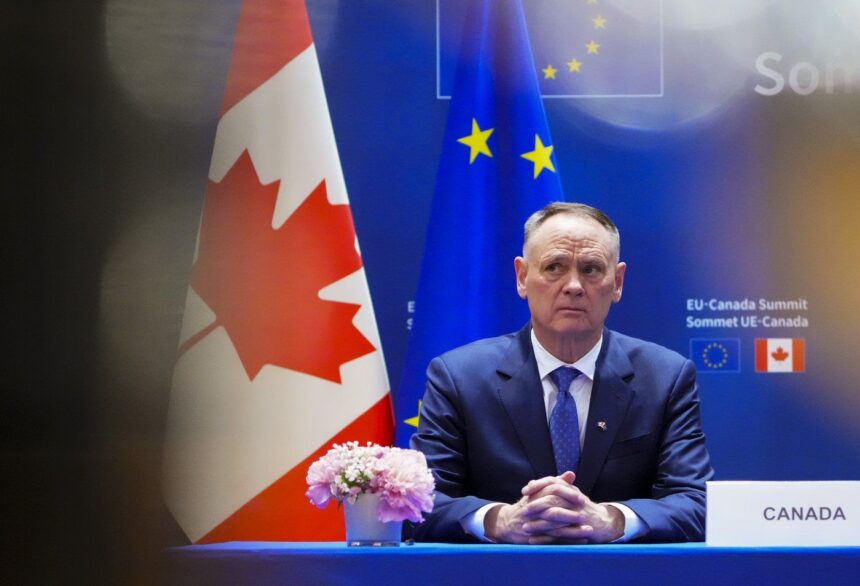I stepped out from a gathering of defense contractors and Ukrainian officials in downtown Ottawa yesterday into the biting June cold – unusually frigid weather that locals joked was “welcoming our Ukrainian friends properly.” The mood inside had been anything but cold. Representatives from Canada’s defense industry clustered around their Ukrainian counterparts with unmistakable eagerness, exchanging business cards and discussing technical specifications.
“This isn’t just about selling arms,” Deputy Defense Minister Yulia Lavrova told me as we spoke in a quiet corner. “It’s about building something together that helps Ukraine defend itself today and establishes industrial partnerships that will last decades.” Her eyes carried both exhaustion and determination – the look I’ve seen countless times on officials working to modernize Ukraine’s defense capabilities while their country remains under attack.
Canada and Ukraine have moved significantly closer to finalizing a military co-production agreement that would enable Ukrainian defense manufacturers to produce Canadian-designed military equipment domestically. According to multiple sources within Canada’s Department of National Defence, the deal – under active consideration for months – would represent Ottawa’s most substantial commitment yet to Ukraine’s long-term military self-sufficiency.
The proposed agreement would initially focus on armored vehicles, drone technology, and communications systems – areas where Canada maintains competitive expertise and Ukraine has immediate battlefield needs. More importantly, it signals a shift from simple arms transfers to deeper industrial integration.
“What makes this arrangement particularly significant is that it’s not charity – it’s partnership,” explained Dr. Michael Byers, who holds the Canada Research Chair in Global Politics and International Law at the University of British Columbia. “Co-production means Ukrainian workers, Ukrainian factories, and ultimately Ukrainian ownership of the capacity to defend themselves.”
Canada has already provided over CAD $9 billion in various forms of assistance to Ukraine since Russia’s full-scale invasion in February 2022, according to Global Affairs Canada. Approximately $2.4 billion of that has been military aid, ranging from lethal equipment to training under Operation UNIFIER.
But this agreement would mark a qualitative change in approach. The Trudeau government appears to be taking cues from similar arrangements already established between Ukraine and other allies, particularly Poland’s landmark deal to co-produce artillery systems signed last September.
Defense Minister Anita Anand refused to provide specifics when approached outside Parliament yesterday, but acknowledged “ongoing discussions about expanding industrial cooperation with our Ukrainian partners.” A spokesperson for her office later confirmed that “co-production options are being actively explored” but emphasized that no final decisions have been made.
Ukrainian officials have been considerably more forthcoming. During his visit to Ottawa last month, Ukrainian Defense Minister Oleksii Reznikov specifically identified co-production agreements as a top priority, arguing they create a “win-win situation for both countries’ defense industries.”
For Ukraine, such deals represent a vital lifeline for its strained defense industrial base. Nearly half of Ukraine’s pre-war defense manufacturing capacity has been damaged or destroyed by Russian strikes, according to a recent assessment from the Ukrainian Strategic Industries Ministry that I reviewed.
“We need to rebuild while fighting,” explained Dmytro Kovalenko, a Ukrainian defense procurement specialist I spoke with via encrypted call from Kyiv. “Co-production with Western partners like Canada lets us access advanced technology immediately while establishing the foundation for our future security. It’s breathing room we desperately need.”
For Canada’s part, defense industry representatives view the arrangement as an opportunity to scale production and potentially open new export markets. At yesterday’s defense industry forum, executives from several Canadian firms expressed enthusiasm for the model.
“Our production lines are already running at capacity to meet existing orders,” said James Wilson, CEO of Armour Systems Canada, who requested his company’s real name be withheld for security reasons. “Co-production with Ukrainian partners allows us to increase output without massive capital investments while supporting a country fighting for its survival.”
The move also aligns with broader NATO strategies to strengthen Ukraine’s long-term defense posture. At the recent NATO Summit in Washington, Secretary General Jens Stoltenberg emphasized the importance of transitioning from emergency support to sustainable defense arrangements with Ukraine.
However, the path to implementation faces significant hurdles. Export control regulations, intellectual property concerns, and quality control standards all require careful navigation. Canadian officials also worry about technology transfer risks, particularly given the active conflict environment.
Additionally, Russia has specifically targeted defense manufacturing facilities throughout Ukraine with missile strikes and sabotage operations. Any new production facilities would likely require hardened infrastructure and enhanced security measures, driving up costs.
Critics also question whether such arrangements might further entrench a permanent state of conflict. “We’re essentially helping build Ukraine’s capacity to fight indefinitely rather than pushing harder for diplomatic solutions,” argued Melissa Thompson from the Canadian Peace Alliance, who I contacted for balance after the industry event.
Despite these concerns, momentum appears to be building. Three separate officials from Global Affairs Canada confirmed that technical teams are working to resolve remaining obstacles, with a potential announcement expected before September.
As I walked back to my hotel along the Rideau Canal last night, the Parliament buildings illuminated against the darkening sky, I couldn’t help but reflect on how this modest North American capital has become yet another hub in the global response to Europe’s largest land war since 1945. For Ukraine, each such agreement represents not just military capability but a declaration that allies believe in their long-term survival as a sovereign nation.
“We’re not asking anyone to fight for us,” Minister Lavrova had told me earlier. “Just to help us fight for ourselves.”






